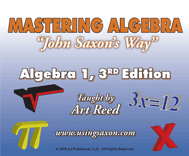

Contents of the Algebra 1, 3rd Edition DVD Series
(120 Lessons)
![]()
Introduction: Prerequisites for the Course - How To Use The Math Book - Expectations of Students.
Lesson 1: Review of Adding & Subtracting with Fractions & Whole Numbers - Using Line Segments as Fractional Parts of a Line.
Lesson 2: The Language of Geometry - Angles, Triangles, Polygons, and Quadrilaterals.
Lesson 3: Definition and Application of Perimeter and Circumference.
Lesson 4: Review of Basic Arithmetic and the Symbols and Algorithms Used in the Computations.
Lesson 5: Composition of the Sets of Numbers - Defining the Absolute Value of Numbers.
Lesson 6: Rules for Addition and Subtraction - Using the Absolute Value in Addition & Subtraction.
Lesson 7: The "Double Negative" - Using Symbols of Inclusion.
Lesson 8: Calculating Areas of Rectangles, Trapezoids, Triangles, Circles & Semi-Circles.
Lesson 9: Rules for Multiplications & Division - Working with Inverse Operations.
Lesson 10: Multiplying and Dividing by Zero - Properties of Multiple Unit Conversions.
Lesson 11: Using Reciprocals - Basic Rules for Order of Operations - Recognizing Addition Patterns from Multiplication Patterns.
Lesson 12: Using Symbols of Inclusion in Order of Operations.
Lesson 13: Working with Multiple "Symbols of Inclusion" in "Order of Operations" - More on the Double Negative!
Lesson 14: Evaluating Algebraic Expressions using Variables and Substitution.
Lesson 15: Computing Surface Areas of Right Geometric Solids.
Lesson 16: Working with More Advanced Evaluations Involving Substitutions.
Lesson 17: Defining Factors, Coefficients, and Terms - Review of the Distributive Property in Multiplication.
Lesson 18: Reviewing the Definition of "Like Terms" and then applying that definition to adding "Like Terms."
Lesson 19: Evaluating Terms Containing Exponents, Powers, and Roots.
Lesson 20: Finding the Volume of Right Geometric Solids.
Lesson 21: Defining the "Product Rule" for Exponents - Adding Like Terms that have Exponents.
Lesson 22: Review of Definitions for Algebraic Symbols, Words, Statements and Sentences - Defining "Equations."
Lesson 23: Defining "Equivalent Equation" - Applying the "Additive Property of Equality" to Equations.
Lesson 24: Reviewing the Multiplicative Property of Equality.
Lesson 25: Solving an Equation for its unknown Variable.
Lesson 26: Working with More Challenging Equations.
Lesson 27: Simplifying Equations Containing Decimals - Advanced work with the "Distributive Property."
Lesson 28: Word Problems Involving Fractions - Applying Functional Notation.
Lesson 29: Rules for Working with Terms Containing Negative and Zero Exponents.
Lesson 30: Defining and Using Algebraic Phrases - Word Problems Involving Decimal Parts of Numbers.
Lesson 31: Working with Equations Containing Symbols of Inclusion (Parenthesis).
Lesson 32: Word Problems Using Algebraic Phrases.
Lesson 33: Working with Products of Prime Factors - Word Problems containing Statements of Unequal Quantities.
Lesson 34: Finding the Greatest Common Factor (GCF).
Lesson 35: Factoring using the Greatest Common Factor (GCF) - Proper use of Factoring in Algebraic Terms
Lesson 36: Using the Distributive Property with Positive Exponents - Recognizing a Negative Exponent from a Negative Number.
Lesson 37: Defining and Graphing Symbols of Inequality.
Lesson 38: Defining and Working with Ratios and Proportions
Lesson 39: More on Symbols of Inequality - Defining & Applying Trichotomy - Working with Word Problems Involving Ratios.
Lesson 40: Working with Negative Exponents - Applying the Distributive Property of Equality to Negative Exponents.
Lesson 41: Advanced Application of Adding Like Terms - Using Substitution in Evaluating Equations.
Lesson 42: Working with Equations Containing More than one Variable.
Lesson 43: Defining and Working with Least Common Multiples in Algebraic Expressions.
Lesson 44: Addition of Rational Expressions with identical and with different Denominators.
Lesson 45: Definition and Application of the Mean, Median and Mode
Lesson 46: Definition and Application of a mathematical Conjunction
Lesson 47: Evaluating Percents - Less Than - And Greater Than - 100%
Lesson 48: Defining and Working with Polynomials of Varying Degrees.
Lesson 49: Applying the Distributive Property to the Multiplication of Polynomials.
Lesson 50: More Work with Polynomials - Defining an "Ordered Pair" on the Cartesian Coordinate System.
Lesson 51: Graphing Linear Equations using the Cartesian Coordinate System.
Lesson 52: Advanced Rational Expressions using Unequal Denominators - Determining "Overall" Average.
Lesson 53: Applying the "Power Rule" to Exponents - Using Unit Multipliers for converting Volume.
Lesson 54: Using Substitution to solve for Unknown Variables in Equations with more than One Variable.
Lesson 55: Establishing Rules for Working with Abstract, Complex Fractions.
Lesson 56: Defining finite and infinite sets of numbers - Advanced Linear Graphing Techniques.
Lesson 57: Adding Algebraic Terms Containing Negative Exponents.
Lesson 58: Advanced Word Problems dealing with Percents.
Lesson 59: Advanced Techniques for solving Two Unknown with Two Equations.
Lesson 60: Finding Volume and Surface Areas of Geometric Solids (Prisms & Cylinders).
Lesson 61: Review of the Subsets of Real Numbers - Introduction to The Calculator (Casio fx260 solar - $9.99)
Lesson 62: Determining Higher Order Roots - Evaluating the notation "+/-."
Lesson 63: Multiplying radicals - Recognizing Repeating Decimals.
Lesson 64: Defining "Domain" - Review of the Additive Property of Equality and its application to the Property of Inequality.
Lesson 65: Adding Radical Expressions - Defining "Weighted Averages."
Lesson 66: Simplifying Radical Terms or Expressions - Simplifying the Square Roots of Large Numbers
Lesson 67: Review of the Definition of an Equation - Solving Multiple Equations using Elimination rather than Substitution.
Lesson 68: Advanced Abstract, Complex Fractions.
Lesson 69: Introduction to Factoring Trinomials.
Lesson 70: Introduction to Probability - Dependency.
Lesson 71: Factoring Trinomials with Common Factors - Should We Use Subscripted Variables?
Lesson 72: Advanced Factoring in Trinomials - Volume and Surface Area of Pyramids and Cones.
Lesson 73: Defining the Difference of Two Squares - More on Probability.
Lesson 74: Review and Use of Scientific Notation
Lesson 75: Linear Equations - Graphing a Line Using the "Slope-Intercept" method.
Lesson 76: Defining "Consecutive Integers."
Lesson 77: Defining "Consecutive 'Odd' or 'Even' Integers" - Word Problems using Fractions and Decimals
Lesson 78: Solving Equations using "Common Denominators."
Lesson 79: Solving Equations containing Multiple Subscripted Variables.
Lesson 80: Working with Scientific Notation involving very large or very small Numbers.
Lesson 81: The Three Categories of Linear Equations (Consistent, Inconsistent, or Dependent)
Lesson 82: Defining and Evaluating Functions - Determining the Domain and Range of a Function.
Lesson 83: Word Problems Using Subscripted Variables.
Lesson 84: Multiplying Radicals - Mapping and Defining Functions and Their Relations.
Lesson 85: Review of "Stem and Leaf" Plots - Using Them to Create Graphs.
Lesson 86: Dividing Polynomials.
Lesson 87: Solving Systems of Equations using an Algorithm - Using the Vertical Line Test to Determine Functions.
Lesson 88: Factoring Quadratic Equations.
Lesson 89: Word Problems Dealing with Money or other Values.
Lesson 90: Word Problems Utilizing Ratios, and the Multiplication, Division, Addition and Subtraction of Numbers.
Lesson 91: Using the Multiplicative Property of Inequality - Volume and Surface Area of Spheres.
Lesson 92: Word Problems involving Equal Distances and Uniform Rates.
Lesson 93: Factoring with Products of Polynomials - Simplifying Abstract, Complex Fractions.
Lesson 94: More Distance Word Problems involving The Sum of Two Different Distances.
Lesson 95: Recognizing and Graphing Unusual Non-Linear Functions.
Lesson 96: Introduction of the "Difference of 'Two Squares' Theorem."
Lesson 97: Re-Visiting the "Pythagorean Theorem" - What is a Pythagorean Triplet.
Lesson 98: Using the "Slope Formula" and the "Pythagorean Theorem" to find the Distance between Two Points.
Lesson 99: More Distance Word Problems involving Uniform Motion, but comparing Two Unequal Distances
Lesson 100: Our "Base Ten" Place Value System - Rules for Rounding Numbers.
Lesson 101: Factoring Trinomials in the Denominator & Using these Factors to find a "Common Denominator."
Lesson 102: Use of the "Absolute Value" in Statements of "Inequality."
Lesson 103: Solving Equations using "Common Denominators" containing "Symbols of Inclusion."
Lesson 104: More Abstract, Rational Equations.
Lesson 105: Using a Technique called "Grouping" to factor Polynomials.
Lesson 106: The "Slope-Intercept Form of Linear Equations - Finding the Equation of a Line Passing Through Two Specific Points.
Lesson 107: Finding the Equation of a Line "Passing through a Specific Point", but also "Parallel" to another given line.
Lesson 108: Solving Radical Equations, using "Symbols of Inclusion."
Lesson 109: Factoring Trinomials using a Different Method ("Factoring over the Integers").
Lesson 110: Shifts and Reflections in the Location of the Vertex of a Non-linear Function
Lesson 111: A New Form of Conjunctions - Introduction to Disjunctions.
Lesson 112: Advanced Multiplication of Radical Expressions using Double "Symbols of Inclusion."
Lesson 113: Introduction to Direct and Inverse Variation.
Lesson 114: Exponential Growth.
Lesson 115: Graphing Linear "Inequalities."
Lesson 116: Rationalizing The Denominator using "The Quotient Rule."
Lesson 117: More Word Problems involving Direct and Inverse Variation using "Squared" terms.
Lesson 118: Factoring a Trinomial Using a technique called "Completing the Square."
Lesson 119: Introduction to the Quadratic Formula.
Lesson 120: Re-visiting "Box and Whisker Plots."
Home | Review the book | Purchase book | Testimonials | Newsletter | Contact Us
© 2006 - 2025 AJ Publishers, LLC
